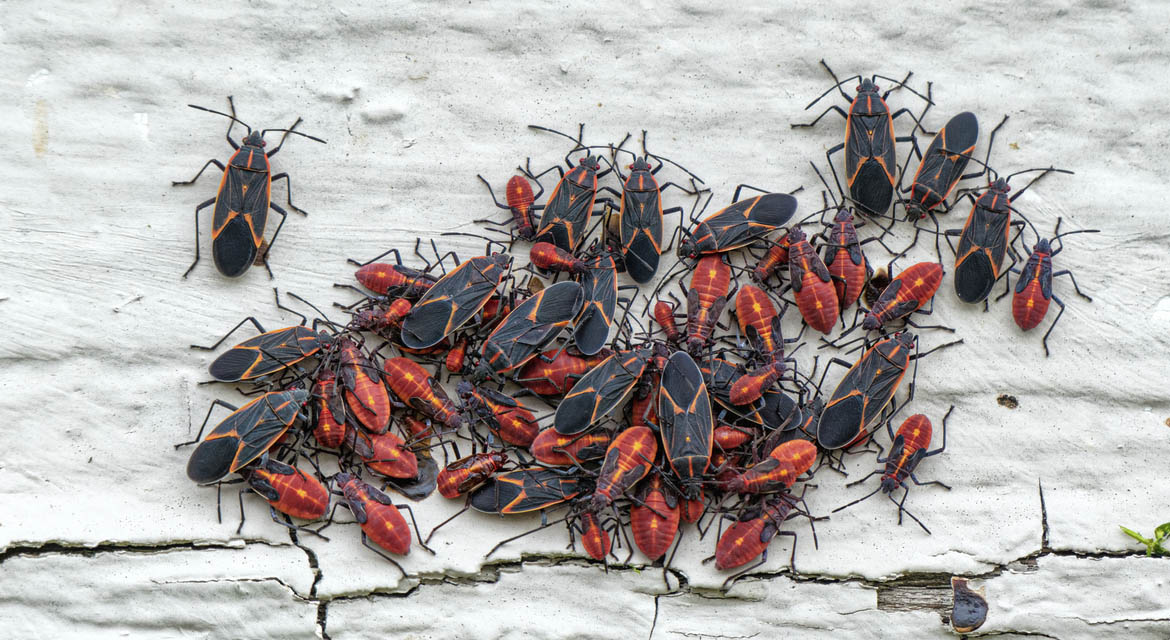The Complete Life Cycle of the Stink Bug
Stink bugs, with their distinctive shield-shaped bodies, undergo a fascinating journey from birth to adulthood. Starting as tiny, barrel-shaped eggs meticulously laid on the undersides of leaves, they hatch into nymphs, which bear a close resemblance to adults, albeit smaller and wingless. These nymphs endure several molts, shedding their exoskeletons to accommodate their growing bodies. Upon completing these molting stages, the nymphs transition into full-grown adults, ready for reproduction. When the cold season approaches, these mature stink bugs tactically seek shelter, with many finding solace in homes and other structures. This phenomenon, termed overwintering, ensures their survival during harsh winter conditions, allowing them to emerge rejuvenated come spring, initiating the cycle all over again.
The Life Cycle Explained
Understanding the four main stages of the stink bug life cycle can help us understand their behaviors and roles in our environment.
The Egg Stage
The stink bug begins its life cycle in a delicate, barrel-shaped form known as an egg. These eggs, pale in hue and often grouped in tight clusters, are discreetly positioned on the undersides of leaves to shield them from potential predators. A female stink bug, in her lifetime, can lay hundreds of such eggs. Once laid, the countdown to hatching begins, and within a span of about a week, tiny nymphs emerge, ready to embark on the next phase of their life.

Not the pest you are looking for?
Check out our pest library to see what other pests we have articles on
The Nymph Phase
As these nymphs emerge, their appearance, although reminiscent of adult stink bugs, lacks the wings and the fully developed body. They are equipped with a voracious appetite, which aids them as they grow and molt several times. Typically, a stink bug nymph will undergo five molting stages, each shedding its exoskeleton to make way for a larger, more mature form. These molts can be differentiated by the gradual development of wing pads and the size of the nymph at each stage.
Adulthood and Reproduction
Reaching the climax of their developmental journey, the nymphs transform into full-winged adults. These adults, characterized by their shield-like shape, are now primed for their primary task of reproduction. An adult stink bug’s lifespan stretches over several months, during which the female will lay eggs multiple times, particularly during the warmer seasons. Reproduction is a cyclic event, ensuring the continuation of the species.
Overwintering Adults
As the frosty tendrils of winter approach, stink bugs demonstrate a keen sense of survival. Instead of braving the chilling winds, they opt to overwinter, a hibernation-like state. To achieve this, they seek refuge in warmer environs, often infiltrating homes and other structures. This shelter provides them with the protection needed to outlast the winter months. As spring begins to bloom, cues such as increasing daylight and temperature signal these overwintering adults to emerge, revitalized and ready to start the life cycle anew.
Stink Bugs in the Ecosystem
It is important to understand the roles, impact, and interactions that stink bugs have in their environment and how it overlaps with their life cycle.
Natural Role and Diet
Within the ecosystem, stink bugs have carved out a niche for themselves as both predators and prey. Their diet predominantly comprises plant sap, which they extract using their piercing-sucking mouthparts. This diet varies slightly as they mature; nymphs often target softer plants while adults can feed on a broader range of plant species, including fruits, leaves, and stems. This feeding habit, while essential for their survival, can sometimes place them in direct conflict with agricultural interests.
Natural Predators and Defense Mechanisms
In nature, stink bugs have many predators. Birds, spiders, and certain insects, such as lady beetles and wasps, often prey on stink bugs or their eggs. However, these bugs are not entirely defenseless. Their name hints at their primary defense mechanism: the release of a pungent odor when threatened, which acts as a deterrent to many predators.
Agricultural Impact
Given their preference for plant sap, stink bugs can be quite detrimental to crops. They not only feed on agricultural produce but also act as vectors for plant pathogens. Their feeding can lead to discoloration, deformities, and even premature drop of fruits. To combat this, farmers have devised various strategies ranging from chemical pesticides to integrated pest management techniques, which might include introducing natural predators of stink bugs to affected areas.
Invasive Species and Ecosystems
Stink bugs, particularly species like the Brown Marmorated Stink Bug, are considered invasive in many parts of the world. Their introduction to new habitats, often inadvertently through trade, can upset local ecosystems due to a lack of natural predators. Such disruptions can lead to stink bug populations thriving and native species declining. Researchers are continuously exploring methods to manage these invasive species, including the potential introduction of their natural enemies from their native habitats.
Other Considerations
Comprehending the life cycle of pests, such as the stink bug, is important for effective management. By understanding each stage of their development, from egg to overwintering adult, strategies can be tailored to curb their population growth at the most vulnerable points. This knowledge equips farmers, gardeners, and pest control experts with the tools to mitigate their impact on crops and ecosystems without causing undue harm to beneficial organisms.
Moreover, in an era where sustainable agriculture is becoming a global imperative, continuous research into pests and their life cycles is invaluable. By focusing on natural predators, understanding breeding patterns, and developing eco-friendly deterrents, we can work towards reducing our reliance on chemical pesticides. This shift not only safeguards our environment but also promotes the long-term health of the agricultural industry, ensuring that future generations won’t be affected by these pest invasions.
Take Away
The life cycle of the stink bug, from egg to overwintering adult, highlights the adaptability of this insect and suggests the importance of sustainable management in agricultural settings. Their multifaceted interaction with ecosystems necessitates informed strategies for population control.

